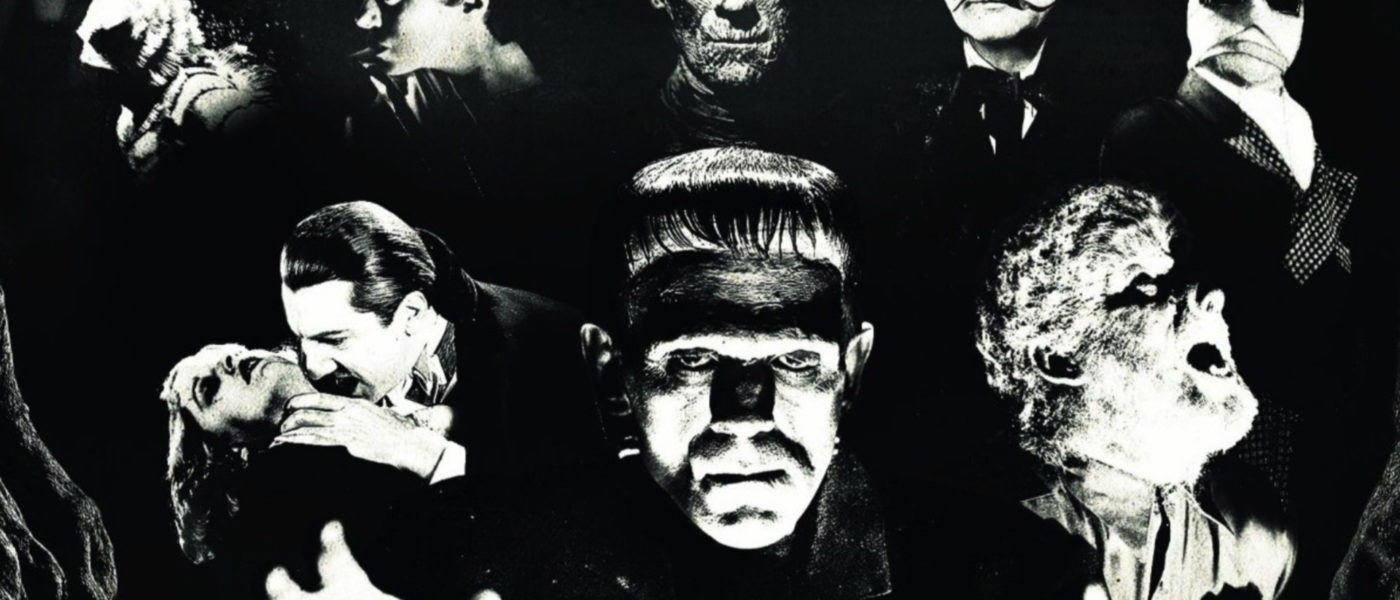Man-made Monsters Dominate our Lowly Quest for Old-School Ghouls!
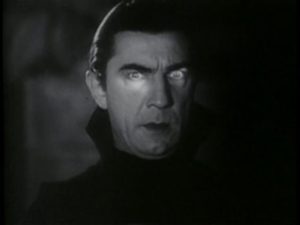
Most any surveillance of slowly rotting bona fide film critic culture will observe a deeply ingrained horror film subset. These are the people who arose to their cinephilia exclusively by way of the horror genre. Their very devoted niche is by far the most pronounced, most outspoken of the fan-turned-critic phenomenon. (Which has been largely replacing the traditional journalist-turned-critic model since the Internet exploded). The critically best of the lot harbor an extended passion for great and/or interesting cinema across the board. The lesser ones are content to remain holed up in their horror hovels, “film buffs” only in that very particular sense. And yes, horror fandom breaks down into ever-expanding subsets within subsets. Needless to say, tread carefully, one and all!
While any self-ascribed genre limitations can indeed be unnecessary barriers, there is no shortage of horror experts that rank among the most astute, the most devoted, and the most curious and adventurous in all of filmdom. These literal and figurative scholars will be the first to confirm that history matters. In particular, classic monster movies matter. The Cabinet of Dr. Caligari. The Golem. Murnau’s Nosferatu… Where would the form be without these seminal German classics?
Horror, like comedy, action, and Westerns, tends to operate in distinct, organic phases. While cynics may be quick to condemningly through-line the genre as a capsulized parade of male aggressions and misogyny (and there’s certainly too much of that in just about any given history), horror at its finest functions as a lucid window into darknesses that are societal, personal, and even cosmic and/or spiritual. Some may even say… universal?
What follows is our own recent first-time explorations into the realm of classic monster movies. The focus was intentionally narrowed to Hollywood productions circa the 1930s thru, say, 1959. (The golden age of Universal Monsters through the radiation-drenched Atomic Age). As you will see, we individually opted to dwell mostly within the early portion (we do have one 1950s creature among us), but quite curiously, within the realm of “Frankenstein” themes- if not overt Frankenstein movies! (Though we do have one bloodsucker). Two even share the same director. Rightly creepy. Only one of the participating contributors match the above-considered label of “horror film critic”. (Greetings, Paul Hibbard) But if these monsters manage to get their hooks in us, you never know what gruesome incarnations may yet emerge!
– Jim Tudor
The Bride of Frankenstein
Directed by James Whale/1935
by Taylor Blake
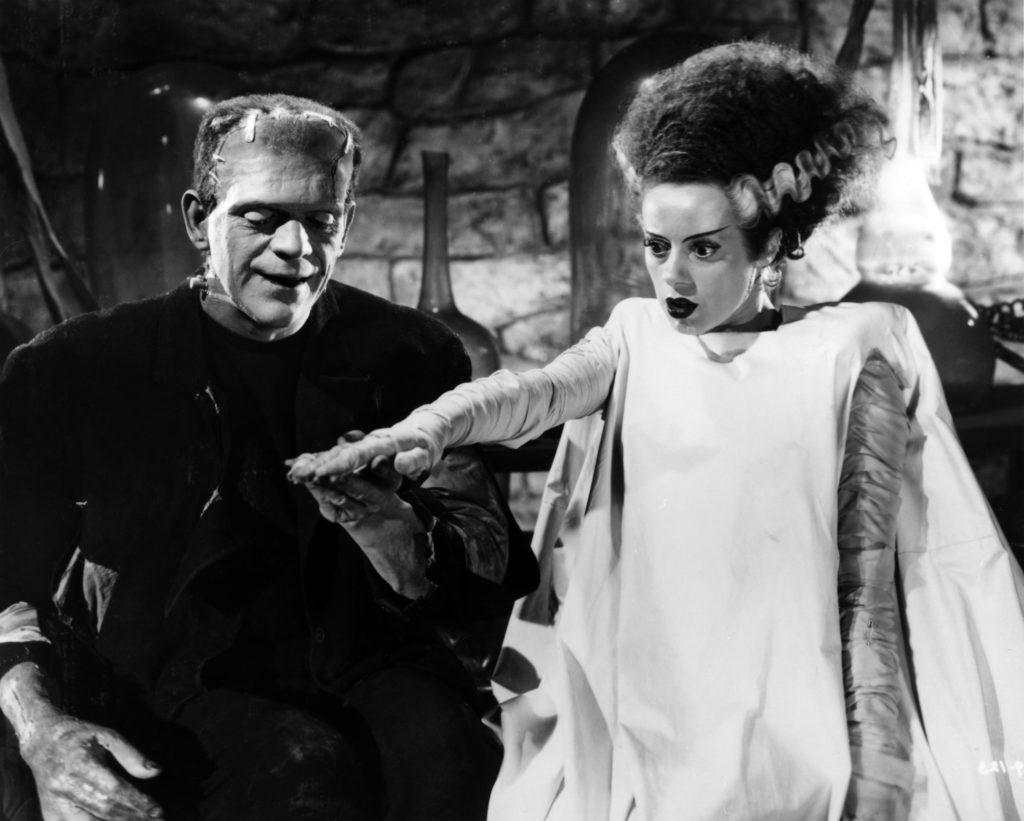
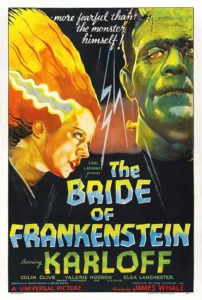
If you want to talk about characters who transcend the film they’re in, you have to talk about The Bride of Frankenstein.
When I fired up this classic, it wasn’t long before I noticed a curious absence. Where was this Bride of Frankenstein? The ticker kept moving across the 74 minutes of red line at the bottom of my screen, and there was plenty of Dr. Frankenstein and his Monster, but where was iconic streaked hair I was waiting for? My friends, we see the first sliver of the Bride’s face with five minutes until the Universal logo appears to call it quits on this story. Can you imagine if Dracula, Frankenstein himself, or any other monster only appeared in the last five minutes of their own film? And would you have expected a character with so little runtime to be so recognizable almost 90 years later?
The Bride of Frankenstein begins with a retcon of the previous film’s ending—the Monster did not, in fact, die as depicted in 1931’s Frankenstein. To the filmmakers’ credit, they introduce this retcon with a clever twist: As an idea from Mary Wollstonecraft Shelley herself. Before she dons the iconic wig, Elsa Lanchester spins a new yarn for Percy Bysshe Shelley and Lord Byron about the aftermath of Dr. Frankenstein’s first experiment. (In another clever twist, the credits don’t reveal Lanchester played both roles, leaving just a question mark for the actress who played the Monster’s Mate.) In short: Frankenstein’s monster must avoid angry villagers with torches, and Dr. Frankenstein grapples with the morality of his work. In short: It’s a version of every Frankenstein story you’ve ever seen. But the plot of is secondary to the vibes, and if you’re looking for a convoluted procedure involving electricity and fake-y science equipment that brings the dead to life—and ripe for the spoofing in Young Frankenstein—there’s plenty of it for you.
But even with only five minutes, Lanchester steals the show with her herky-jerky movements, icy glare, and chic, minimalist wardrobe. She may have just died, but she’s stunning—we’re as taken with her as the Monster is. And since we spent the film sympathizing for a Monster who can only befriend a blind man, we’re crushed when she screams in fear like a banshee. What’s more horrifying than the idea that someone made for you is repulsed by you?
More confusing than horrifying: How did the Bride not return for another film? In 2021, a sequel would be greenlit on the spot for a character so memorable and meme-able. This one seems like a no-brainer! (No disrespect meant to the Monster and his Mate’s reused brains) Since 1935 she’s been referenced in sci-fi/horror films ranging from Bride of Chucky, The Rocky Horror Picture Show, Mars Attacks!, Weird Science, and last year’s Hubie Halloween. She’s been spoofed on Saturday Night Live and The Simpsons, and she has inspired Halloween costumes on Brooklyn Nine-Nine, Everybody Loves Raymond, and even Disney Channel shows like Jessie and Phineas and Ferb. She’s a universal reference (if you’ll pardon the pun), so it’s no surprise it was just announced Scarlett Johansson will be slapping on the wig for a remake. While Lanchester’s performance leaves a long legacy, there’s plenty of story still to explore for this character, so something tells me A24 and Apple TV+ will be smart enough to give her more than five minutes to shine.
House of Frankenstein
Directed by Erle Kenton/1944
by Robert Hornak
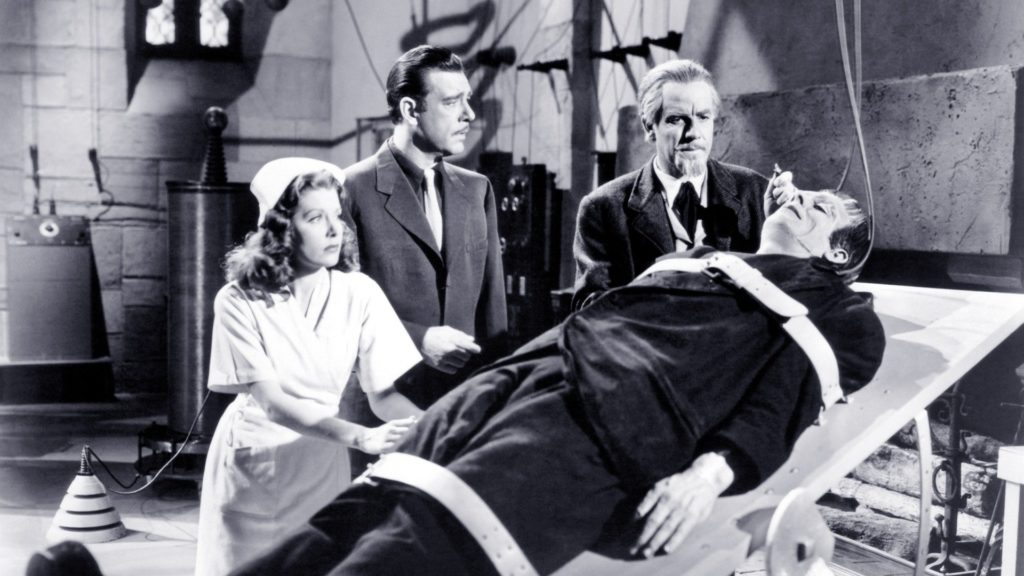
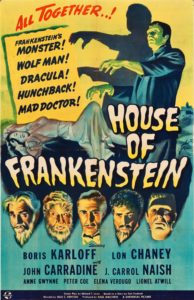
We’re immediately in that rarefied Universal horror framing that leaves enough headroom over every character to make the vastness of the various jails, castles, and laboratories right characters of their own. The look is Universal perfect, all chiaroscuro and expressionism, with lightning bolts and dark forests and gypsies with sidelong glances, all shrouded tight in mist and dripping violins. If anything, director Kenton proves just how easily melded the worlds of Dracula, the Wolf Man, and Frankenstein are – like three scenes from the same nightmare. While the look is there, the plot is a back-row middle schooler’s fever dream – a concoction that reads like a pitch by a prankster or a drunkard, a confection that only a cynical, money-grubbing studio could love – it’s uncontainable in this space, but let’s suffice it to say: mad scientist restores life to Dracula, who kills his enemies for him, then, in a headlong plunge into hubris, revives Frankenstein’s monster in order to switch its brain with that of the also revived Wolf Man. All goes wrong, even the hunchbacked assistant is miffed, and the whole thing ends with more dead players than Hamlet.
Inside the brackets of What To Expect in a classic Universal monster movie, it’s half compelling and half hoot. There are no actual scares so much as tacit nods toward suspense in the form of: just how are they going to get these three classic monsters in a scene together? That suspense is not fulfilled, as all of the first thirty minutes is Dracula only, dispatched by the rising sun at about the half-hour mark, just about the time the plot doesn’t need him anymore. Then we’re in another town with another set of secondary characters linked only by the mad scientist’s frothy lust for the secrets of the dead. While Frankenstein’s creature and the Wolf Man are sometimes in the same room together, the creature isn’t re-animated until well after Wolf Man is felled by his true love’s silver bullet. So there’s no monster-fu to speak of – and isn’t that what any self-respecting monster-mashup should deliver. Imagine Freddy vs. Jason or Alien vs. Predator with no title-teased showdown.
I was excited to watch the movie when I saw it featured at least two original Universal monster actors: Boris Karloff and Lon Chaney, only to discover Karloff isn’t Frankenstein’s monster. He plays the mad scientist Niemann, self-described as the brother of Frankenstein’s old assistant, while Glenn Strange plays the monster (his first of three outings as the bolted one) in the less-than-compelling manner of a gassy somnambulist with outstretched arms and perma-grunt, a bit that usurped Karloff’s brilliant nuances as the cultural shorthand for who the creature was. This actor-to-role switcheroo at least has a juicy meta tradeoff in the end, as Karloff’s scientist finds himself in the clutches of the monster, staring into the face that made him famous. Meanwhile, we get Chaney in full mope mode, doing his “kill me before I kill again” routine, with the bizzaro variation “operate on my brain, unvetted surgeon, before I kill again.” For this werewolf fan (the idea of the werewolf is my favorite old-school monster conceit – changing into something against your will creates so much more inherent drama and pathos), this movie gives the short-shrift, including only two transformations, and little actual screen time for his hirsute pursuits. One wonders about director Kenton’s possible foot fetish, as the first transformation cleverly focuses on Larry Talbot’s footprints changing from feet to paws, while his final transformation back into a man is shown entirely ankles down. It should be noted that there is no Bela Lugosi, he who is synonymous with Dracula. Here the vampire is played with some relish by a reasonable stand-in, the great John Carradine. Perhaps Lugosi’s ego couldn’t handle a script that offed him, Marion Crane-like, at the first act break.
All of the above considered, the movie is actually fairly entertaining, possibly owing to the quick pace necessary to include so much schlocky plot inside the mandated 60-ish minute B-movie running time. Or it could be that Karloff brings his typical genteel manner to even this mad scientist role, providing some grounding to the electricity ball of activity surrounding him. Or it could be that I’m subconsciously comparing it to the next year’s sequel-upon-a-sequel, House of Dracula, which belongs deep down in the quicksand pit that concludes this film.
Drácula
Directed by Enrique Tovar Ávalos, George Melford/1931
by Paul Hibbard
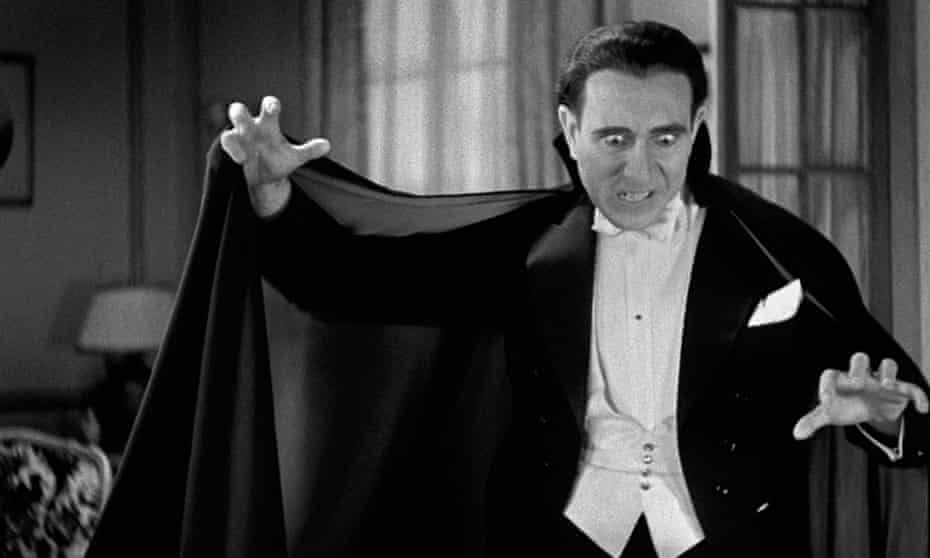
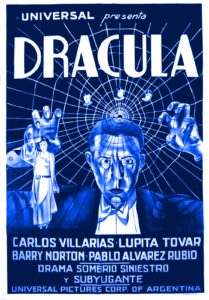
True confession – Legosi’s Dracula has never been my favorite film. I think it’s one of the weakest of the Universal Films and shouldn’t be in the same discussion as Frankenstein or Bride of Frankenstein. It’s not Browning’s best movie (I’d say Freaks). It’s not the best film version of Dracula (I’d say Nosferatu). And Legosi isn’t the best version of Dracula (I’d say Christopher Lee).
So when I heard that there was a Spanish language version of Dracula that was made concurrently, at night with the same sets, I became intrigued. When I heard it was considered superior by some, I was very intrigued.
After watching, I’d like to add my voice to those who think it’s better, but more by default. To me, it still pales in comparison to other Draculas.
Carlos Varias is a flawed Dracula. Whether he’s better than Legosi or not, to me, is a flip of the coin. He doesn’t play it to such an extreme, instead he just looks so simple and unassuming in the role. He looks like your friend’s dad and not like the seductioner of evil.
The supporting characters I did like more than the English versions, especially Pablo Rubio’s performance as Renfield.
From there, a lot is just the same. Same awkward pauses, same beautiful production design, same goofy moments like a bat riding some horses. And say what you want to defend that moment in either version by saying it’s part of the time, I’d counter with saying Nosferatu which came out 9 years earlier had nothing like that.
A mixed bag, but enough in it to watch for a complete understanding of the history of horror. Much like Browning’s version.
The Creature Walks Among Us
Directed by John Sherwood/1956
by Justin Mory
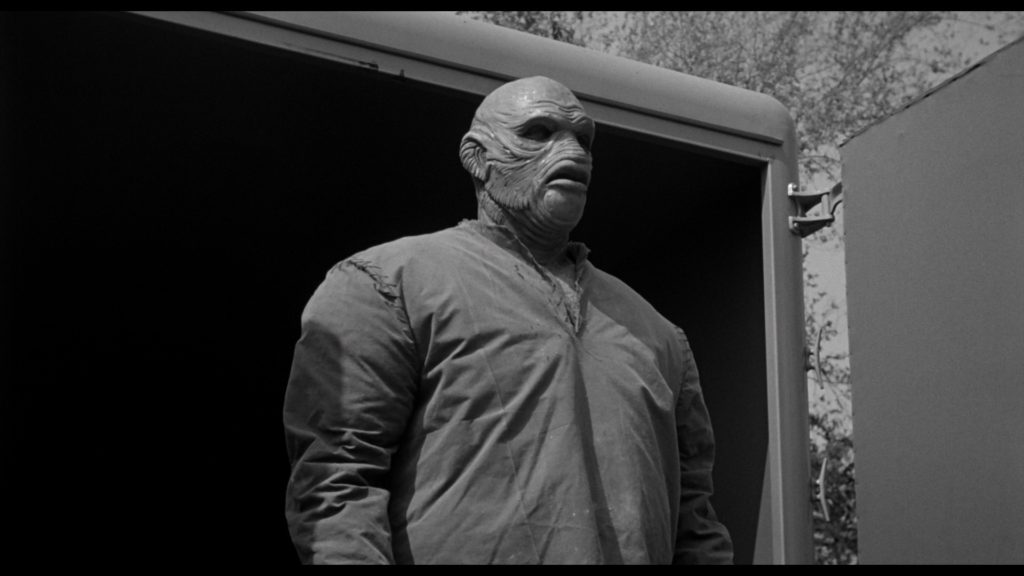
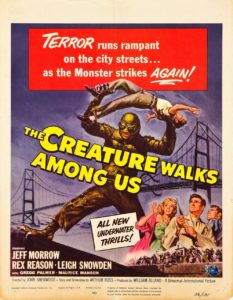
Called “The Creature” in three titles produced in the exact middle of an anxious movie decade that had no screen-shortage of created threats – from outer space, atomic fallout, or body mutation – Universal Studios, which by then, through the extraterrestrial threat of televisual fallout, had mutated into the less potent Universal-International, took the final monster of its classic era from its peaceful underwater repose in the Amazon to public display in a Florida Oceanarium; and finally hunted him out from his new watery home in the Everglades to be again confined, this time as a land creature, in a scientific compound in cruel, picturesque view of the Atlantic Ocean. Shorn of his gills, unable to survive now in water, and the protective layer of his outer scaly membrane burned away – revealing vestigial, human-like skin underneath – our reconfigured creature now lumbers on land where he once gracefully swam undersea. The Creature is now one of us, or something more closely approaching us to whatever missing link between land and water he originally was, and the newly visible aqua vitae of his transparent eyes tells us he doesn’t like what he sees.
The mid-midcentury sweep of Creature films, from 1954 to 1956, produced in quick succession Creature from the Black Lagoon, Revenge of the Creature, and the film under post-watery consideration, The Creature Walks Among Us. In adding the article to the last title, however, the third and final film takes away the former half of the name given in the second film to the amphibious, prehistoric Creature. Gill-man no longer, and man only insofar as we more readily recognize how pitifully he now appears in his new environment, the Creature nevertheless remains a nearly invulnerable threat with a size twice that of a normal human and strength exceeding a dozen men. After (again, cruelly) subduing and capturing him, the usual cluster of Dr.-prefixed field academics (once again, cruelly) descend to study and test him, with one unusually disturbed doctor aiming to somehow utilize the Creature’s differing biological structure in order to genetically engineer humanity past the boundaries of evolution and nature; but the Creature’s natural cunning and predatory instincts, as always, make so many mulched minnows out of the increasingly sophisticated tools used against him.
The usual if cursory online research which accompanies such short write-ups – a few clicks and scroll-throughs on Wikipedia, admittedly – reveals many intriguing tangents to this first-time view, including the Creature films’ prolific B-producer William Alland, who first came up with the original idea based on stories heard while acting in Citizen Kane (1941), but what one couldn’t immediately find, regarding another point of origin-interest, was the source of a certain, unforgettable musical-sting that accompanies the Creature’s every – and I mean every – jarring screen-appearance. Although a young Henry Mancini, as a Universal contracted composer and musician during the mid-fifties, contributed to the first and this final film’s score, one’s more romantic hope is that this particularly overused piece of musical notation – less a theme or passage than a forceful conglomeration of musical tones – sprang somewhere equally mysteriously from the fathomless depths of the Universal sound-recording vault. Buried and mutated under the Frankenstein-Dracula-The Mummy-The Wolfman progression of Universal monsters past, the Creature’s “sting” emerged from that murky origin to make monstrosity relevant for a new, uncertain decade; only to recede and fade in the end back to the ocean-floor cutting-room from whence it came. Whether the Creature can survive in those murky depths without gills, or whether his musical theme can still sound underwater – hurling unwary auditors back to the Devonian era with its every clashing discord – remains to be seen and heard.
Island of Lost Souls
dir. Erle C. Kenton/1932
by Jim Tudor
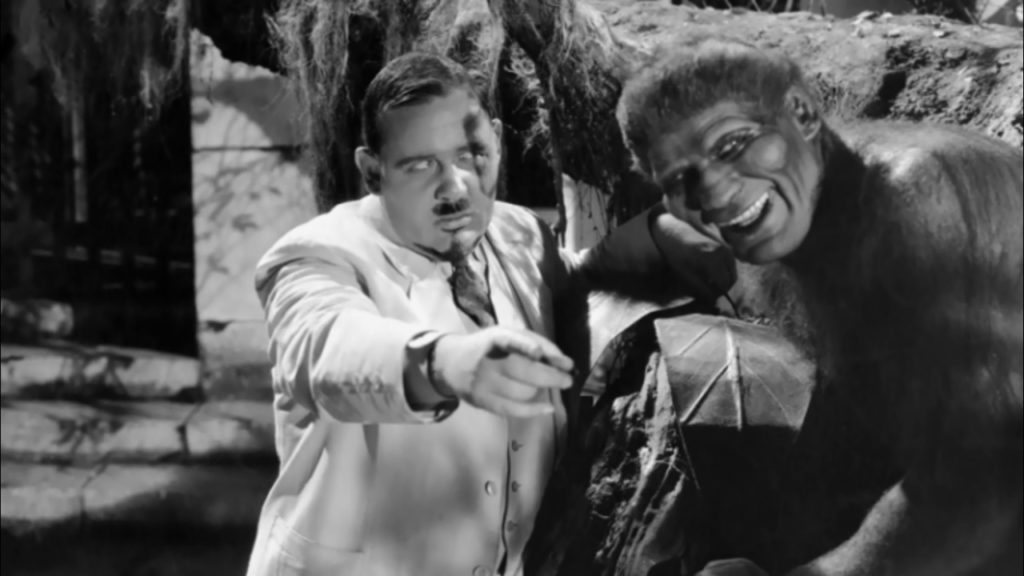
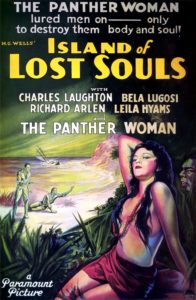
Somewhere on the remote outskirts of the Famous Monsters Filmland lies a remote and often unrecognized place. Produced by Paramount Pictures in the salacious pre-code era (1932 to be exact), director Erle C. Kenton’s Island of Lost Souls has quietly languished, shrouded in eerie fog and moral oddity. Like so many of the great creature features of the moment (Tod Browning’s Dracula; James Whale’s Frankenstein and The Invisible Man; Mamoulian’s Dr. Jekyll and Mr. Hyde, to name a mere few), the film is an adaptation, however loose, of a Victorian novel of some distinction. In this case, it’s H.G. Wells’ Island of Dr. Moreau making the ghastly transformation to the silver screen.
Like Wells’ novel, the film explores issues of medical experimentation gone mad. Though Kenton never emerged as a director of note, his Island of Lost Souls find itself uneasily alive, just as it ought. Per the story, the megalomaniacal Dr. Moreau has holed up on a small uncharted island in the South Seas. There he performs insidious experiments on all manner of unwitting animals, vivisecting and operating to force Darwinian theory to its endgame as he understands it: humanity. But then, if living beings can evolve, then certainly they can also devolve…
Island of Lost Souls is a gloriously off-kilter movie, luminous in its lighting yet effectively remote in its isolated jungle vibe. That the great Charles Laughton stars as the menacing Moreau should not shock anyone, though the fact this, of all roles, is one of his most restrained is indeed most unexpected for this first-time viewer. As Moreau, he is altogether gathered and armed in his fine white suit. But his whip a little too smart, his gun perpetually un-cocked. It’s a corked-up madness in the face of the primal rendered upright. It’s with twisted voyeuristic glee that he attempts to mate his sensual Panther Woman (a scantily clad custom job, played by Kathleen Burke) with the stranded and perpetually outraged lantern-jawed Edward Parker (Richard Arwen).
Laughton, though, is absolutely correct to dial back. The madness generated in the character’s anesthetic-free surgery/torture chamber, dubbed “The House of Pain”, is plenty over-the-top on its own without Laughton also going full tilt. Fir this, look no further than Bela Lugosi’s hairy-faced Sayer of the Law, a transformed creature of authority over his fellow beast men. Lugosi’s words, like his scenes in this picture, are few. He does, however, make the most of his declarations of “Are we not men??”, and “You broke the law!!”
With its overt themes of survival, sexual perversion and God-complex, it’s a fine to report that Island of Lost Souls earns its continuing place in the pantheon of noteworthy classic monster films. Though Criterion’s wonderful Blu-ray edition from nearly a decade ago has done much to maintain if not bolster the film’s reputation, it does nevertheless linger in the lesser-known batch of its contemporaries. “Why isn’t this movie more famous?”, wonders make-up master Rick Baker during an interview on the disc. Why indeed, Mr. Baker. Why indeed.


